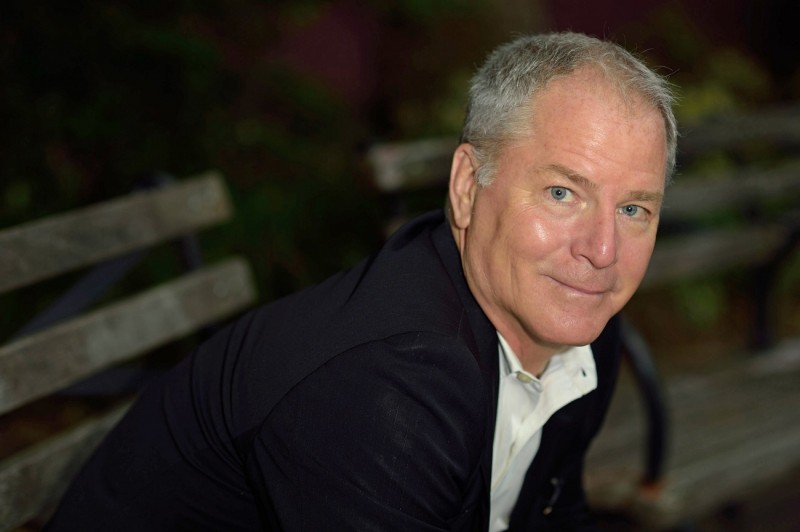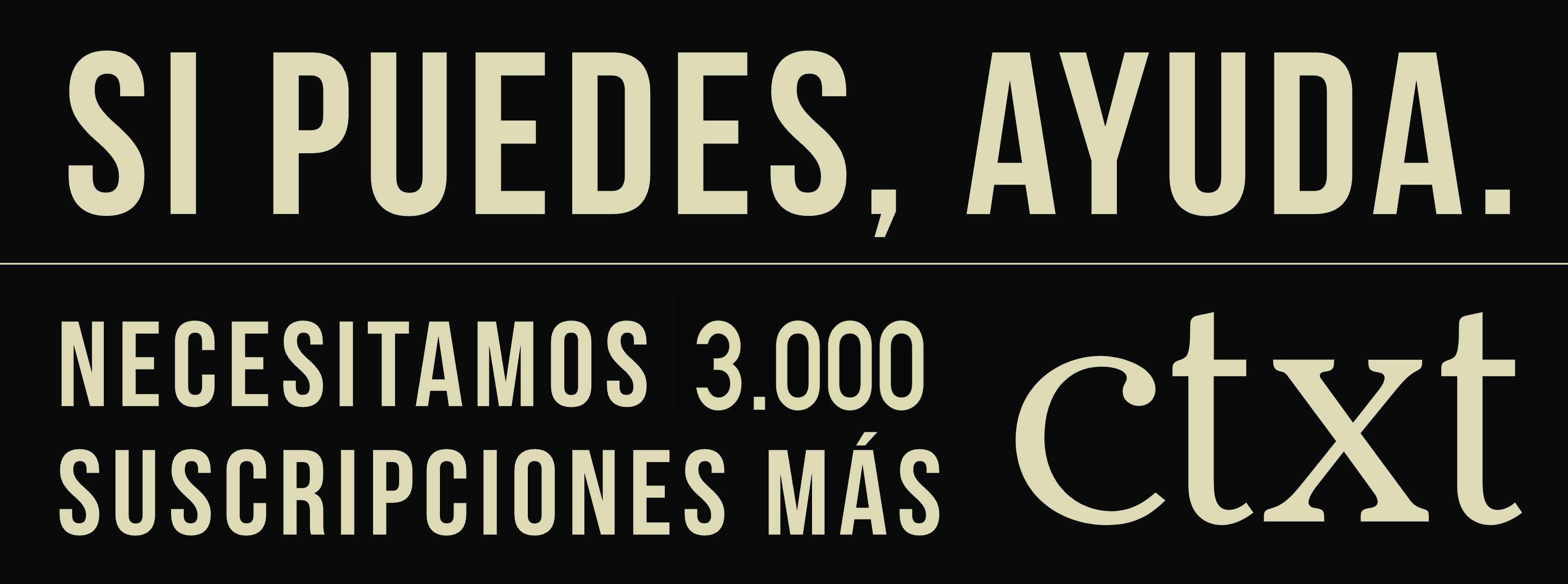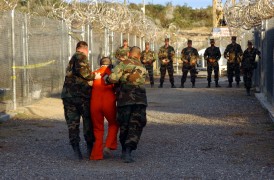LARRY SIEMS/ EDITOR OF 'Guantanamo Diary'
"Torture dehumanizes both the torturer and the tortured"
Álvaro Guzmán Bastida 10/04/2016

Larry Siems.
Donna F. AcetoEn CTXT podemos mantener nuestra radical independencia gracias a que las suscripciones suponen el 70% de los ingresos. No aceptamos “noticias” patrocinadas y apenas tenemos publicidad. Si puedes apoyarnos desde 3 euros mensuales, suscribete aquí
Larry Siems has spent his life amplifying the voices those in power work to mute. His first book was a collection of letters from Mexican undocumented immigrants to their relatives back home. His second, The Torture Report, put into context –and humanized- the 140,000 pages’ worth of government records relating to abuse of prisoners by U.S. forces after 9/11. He has taken that a step further in his latest work by editing the manuscript of one of those prisoners, the Mauritanian Mohamedou Ould Slahi, who has been detained without charges for 14 years, and who wrote a Guantanamo Diary (Little, Brown Company, 2015) from the same cell in which he sits, relating a transfixing story of torture, redemption, abuse and compassion.
How did Mohamedou Ould Slahi wind up in Guantanamo?
He was known to the US Intelligence community before 9/11. He had been interrogated in early 2000 because this guy who went to his Mosque in Montreal was arrested trying to enter the US with a truckload of explosives. Before that he had lived in Germany, and gone to Afghanistan in 1991-92, where he joined Al Qaeda to fight the Communist-backed government there. When that Civil War ended, he left Al Qaeda, but he still had friends from those days who lived in Germany. Most importantly, he had a second cousin who was also a brother in law, a Mauritanian poet-cleric who actually stayed in Afghanistan, and became part of Bin Laden’s council of spiritual advisors. So I think we grabbed him in desperation after 9/11 because we didn’t know much about anything. We just kind of rounded up all the usual suspects, and hoped that maybe he knew something.
What happened then?
He got sent to Jordan, secretly. The Jordanians torture him, they keep him in hiding, even when the Red Cross visits, they take him to the basement. But they clearly conclude that he was innocent, and were going send him home. But at that point we couldn’t send him back to Mauritania because nobody knew we were secretly sending people to Jordan, so that would have been embarrassing. So the military dumps him in Guantanamo.
He thought he would have it better in Guantanamo, right?
Yes, but he gets into Guantanamo just as this battle is emerging between the FBI and Donald Rumsfeld, who wants to have ‘the cool guys in town’ -the CIA- who are beating people up in the black sites. They pick up Mohamedou, who they can’t find anything on, so they figure, ‘he really must be a bad guy, so are going to break him and prove it.’ He became this kind of projection of American paranoia. There’s that amazing scene where they come to him and say, ‘You’re number one on the list,’ and he says, ‘What’s your checklist?’ and they say, ‘Well, you’re Arabic, you speak a bunch of languages, you studied a technical discipline, you lived in Europe for all this time, and he’s like… ‘And?’ That’s the resume of a really successful immigrant, but put on a different pair of glasses, and it suddenly becomes our worse jihadi nightmare.
Some people would argue he was involved with the wrong kind of people and that he has an incentive to say he’s been tortured. Why should people believe him?
There’s an extensive documentary record, that includes two major US government reports that describe his interrogation plan, the memoranda for the record that his interrogators kept. He would describe things, and I could go right back to the documents and find them described in almost the exact same way. So, the scene where Mr. X drags him in into a room and shackles him and plays ‘Let the bodies hit the floor,’ the memo from his interrogators says exactly that happened. There’s nothing that’s not corroborated, and if anything, he’s actually quite sensitive to not sensationalizing his story. He says, ‘I just told the truth, and if people don’t believe it, let me go into court to convince them. Let me call witnesses.’
You talk about the Special Interrogations Project they made specifically for him. How long did they spend devising it?
It took about five months’ worth of drafts. The original plan was to put him in a helicopter, fly him over the Caribbean and threaten to throw him out, but they decided not to do it, because General Miller, who was running Guantanamo, thought too many people would know. They actually revised it several times until Rumsfeld signed it.
What did the special interrogation project consist of?
It goes from May of 2003 until early 2004. It begins with ever-increasing isolation and moving him into places where he can’t tell whether it’s day or night- only through the toilet drain in his cell. Then there’s sleep depravation, round the clock interrogation, three shifts of interrogators, shackling in stress positions, where he is forced to stand up hunched over, wrists shackled to his back, for hours and hours and hours; leaving him in freezing cold rooms, with little or no clothing on, sometimes dowsing with water, so he’s practically hypothermic; heavy metal music and strobe lights- this assault on his senses- putting him in a room and making him listen to the National Anthem on ear-splitting volume overnight, over and over again; putting him in rooms with photographs of body parts from 9/11 and playing the national anthem –you know, weird creepy stuff; sexual assault by female guards who strip and molest him, and ultimately, a fake letter and this staged kidnapping.
What was the staged kidnapping like?
They take him out into the Caribbean, they have an Egyptian and a Jordanian interrogator who are working for us, who beat him up badly and they drag him into this isolation cell, and then, as he is in this broken-down physical state, they still deprive him and are banging on his bars to keep him awake, wake him up, make him drink water so he has to pee all the time and can’t sleep - and then he just breaks.
He breaks. What did torture do to him?
You just lose your will to fight anymore. You’re being told every day that you can make this stop if you just tell us, you know. And as he says, if you go through this for two or three years, like he had, you get a pretty good idea of the stories that they want to hear. So you just start telling them.
What did they want to hear?
Ultimately, essentially testimonies into other people. One of the really shameful things about Guantanamo is that rather than releasing people that we knew shouldn’t be there, we started to use prisoners to develop cases against other prisoners, just to keep them locked up. And that’s what they were doing with Mohamedou.
You write in the introduction that very early on, they knew they didn’t have much against him. How early did they know that?
By the time he got to Guantanamo, they probably knew that he had nothing to do with the 2000 plot. After about a month, we capture this guy, Ramzi bin al-Shibh, who was connected to 9/11, and it turned out that he and Mohamedou had crossed paths, and bin al-Shibh had stayed with Mohamedou for one night in Germany. That was a trigger that made them think, ‘Oh maybe this guy is involved in something, he is connected to the hijackers.’ By the time he has his habeas corpus case in 2010, the US admits that he didn’t even know about 9/11 ahead of time.
So, he’s never charged, and the judge ruled his release. But the Obama administration appealed in order to keep him locked up. What’s the status of his case?
He has a review hearing on June 2nd, which could move him into the category of prisoners who are cleared for release. I think it’s possible he’ll be home by the end of the year.
What was it like working with a writer whom you’ve never personally met?
It’s very, very strange. I worked for the writers’ organization PEN for many years, directing a program which does case advocacy for writers who are in prison in different countries, so I’d seen a number of prison manuscripts. First of all, it was never as substantial and gripping as literature as this was. But also, because the censorship was my own government, it was an extreme challenge.
How so?
I spent all my life as a human rights’ advocate protesting or challenging violations of free expression in other countries and here I was confronted with it in its most extreme form –by my own government. I have this manuscript that’s substantially censored, and then they have the author in an extremely incommunicado lockup, unable to speak for himself. It really sharpened by sense of responsibility to him and to the significance of this manuscript.
Most human rights advocates do work in or related to countries other than their own. What does this tell you about the state of your government –of your nation- now?
It certainly is one of the most challenging realities that I’ve had to deal with in my life. My work was often focused abroad, and it was often criticizing foreign governments. And after 9/11 in very quick succession, a number of things happened that made it impossible to do that without a sense of hypocrisy. That was the bottom line. We would protest the arbitrary detention of journalists in Eritrea, two months after 9/11, and the Eritrean government immediately pointed to the United States. So you knew that if you were at all committed to these principles, you had to look inward.
How did you get a hold of the manuscript?
I knew there was a manuscript because he’d mentioned it in his 2004 hearing, which was declassified. His attorneys handed me this CD-ROM with a PDF file and I went home, printed it out, and sat on my couch and I spent all night reading and I couldn’t believe it. You can read about ‘enhanced interrogation techniques,’ you can read about sleep depravation, you can have this debate about ‘is it torture or is it not’, but just to have someone tell you what it feels like, writing from inside Guantanamo, has amazing value.
That’s what this book provides?
Absolutely. It gives you the flesh and blood life experience of detention not only in Guantanamo but in a number of security prisons in a number of countries. And it does the thing that all good literature does, which is to reveal these places to be very human places, places not only of relentless darkness but also of endurance, courage, real human connection, empathy, moments of respect, moments of forgiveness, all of those things. When you censor a story by taking away the first-person human side, it doesn’t tell the full size of the horror, but it also doesn’t show the complexity of the human experience inside that situation, where people do preserve that humanity.
Including captors…
Including captors! Absolutely. They’re constantly struggling with conscience and moral confusion. Like when a guard says ‘I know I can go to hell for what I just did to you,’ or a female interrogator who sexually assaults him, at one point she says, ‘Do you hate my country?’ and he says, ‘I don’t hate anybody,’ and she goes, ‘I’d hate my country if I were you.’ It’s one of the facts about torture –it dehumanizes both the torturer and the tortured. And one of the things that you see in the book is this sense of the struggle of the prisoners on one side and then the men and the women working as prison guards both trying to save the humanity in all of this.
There are over 2,600 redactions in the book. What role does censorship play in the War on Terror?
At first it existed explicitly in order to open the door to abuse. You needed to remove people from the legal spaces for detention. So you kidnap them, you disappear them, you don’t even tell their families they are, so they can’t tell their story. Censorship was really about creating secret spaces where people could be abused, and that was Guantanamo, where you moved people away from the protections of the Geneva Convention, and it was the CIA Black Sites- entirely secret prisons. Then, after 2004, the censorship has really existed to suppress the information, the evidence of the things we’ve done, in order to prevent accountability. If you think of torture as dehumanization, it’s essential that the people that you’ve applied the torture to not have a human face.
Why is Mohamedou still in Guantanamo?
I believe it’s because he is such an effective communicator, and if he would have been released in 2005 or 2006, about the time he had written this book… Look at his picture; think of how funny he is; think of how well he speaks English; he would have been on CNN all the time, saying, this is what has been going on.
One final question: You write that you still don’t understand why he has been detained for all this time. Does his story illustrate a larger point about the US War on Terror following 9/11?
People ask me a lot about Guantanamo and policy questions. But I just – I look at it through the opposite end of the telescope. This is a justice question. Is each person being treated according to what he or she deserves? And there’s no way to read Mohamedou’s account and not understand how unjust it is to treat a human being that way, in an open-ended detention, without a chance to make a case, to know what your fate is, to have any kind of judgement. There’s nothing fair about that process. We shouldn’t be asking why is this guy still in Guantanamo. That’s an outrageous thing. The man has been in detention for fourteen years; there should be an answer to that question. And if there’s not, that does not correspond to anybody’s understanding of justice –not mine, nor his, his family’s, your family’s –anybody’s. It’s that simple.
Versión española aquí
Larry Siems has spent his life amplifying the voices those in power work to mute. His first book was a collection of letters from Mexican undocumented immigrants to their relatives back home. His second, The Torture Report, put into context –and humanized- the 140,000 pages’ worth of government records...
Autor >
Álvaro Guzmán Bastida
Nacido en Pamplona en plenos Sanfermines, ha vivido en Barcelona, Londres, Misuri, Carolina del Norte, Macondo, Buenos Aires y, ahora, Nueva York. Dicen que estudió dos másteres, de Periodismo y Política, en Columbia, que trabajó en Al Jazeera, y que tiene los pies planos. Escribe sobre política, economía, cultura y movimientos sociales, pero en realidad, solo le importa el resultado de Osasuna el domingo.
Suscríbete a CTXT
Orgullosas
de llegar tarde
a las últimas noticias
Gracias a tu suscripción podemos ejercer un periodismo público y en libertad.
¿Quieres suscribirte a CTXT por solo 6 euros al mes? Pulsa aquí





